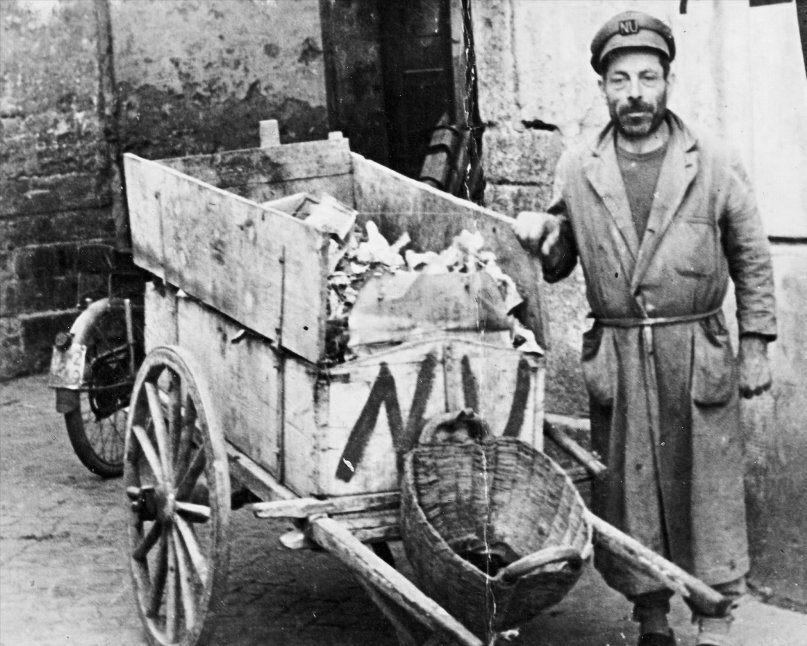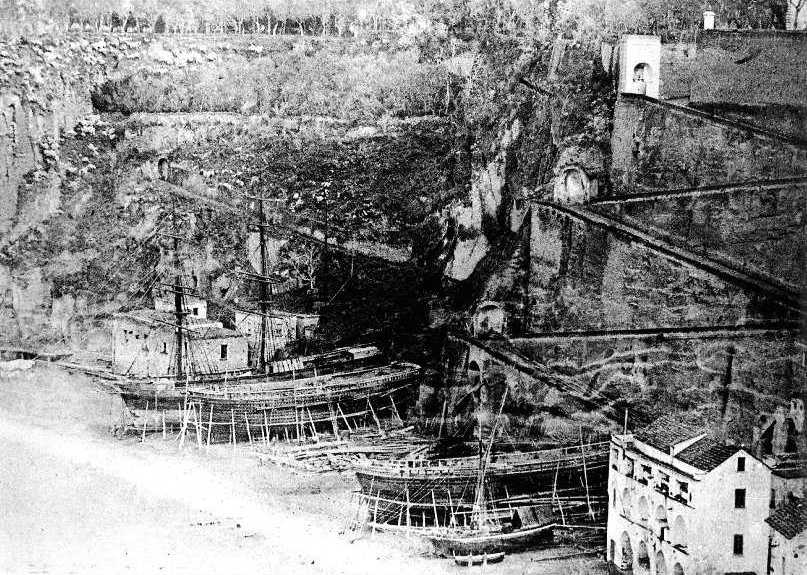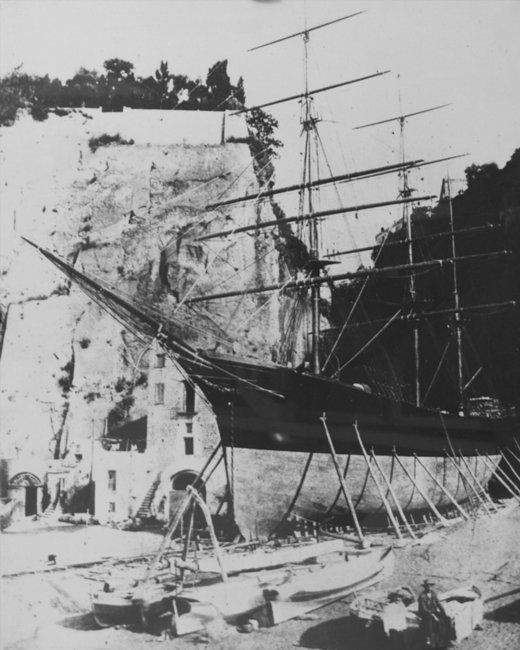Artigianato e mestieri
- lavori in ferro battuto
- ricamo
- intarsio
- cantieri navali
 Anche se i casali sorrentini andarono a distinguersi, dal secolo XVIII, tra le comunità del Regno di Napoli per il prevalere in essi di attività economiche extra-agricole e per la presenza di un artigianato specializzato, tuttavia sarà sempre l’agricoltura, incrementata dalla coltivazione a carattere intensivo degli agrumi e dalla loro diffusione, a determinare un ulteriore sviluppo dei traffici marittimi con il conseguente incremento delle attività cantieristiche.
Anche se i casali sorrentini andarono a distinguersi, dal secolo XVIII, tra le comunità del Regno di Napoli per il prevalere in essi di attività economiche extra-agricole e per la presenza di un artigianato specializzato, tuttavia sarà sempre l’agricoltura, incrementata dalla coltivazione a carattere intensivo degli agrumi e dalla loro diffusione, a determinare un ulteriore sviluppo dei traffici marittimi con il conseguente incremento delle attività cantieristiche.
Ciò evidenzia la circolarità e l’interdipendenza tra le attività del Piano, cui sarà sempre legata l’evoluzione del territorio.
D’altro canto, gli scafi prodotti dai cantieri della penisola, oltre che essere adibiti ai collegamenti con la capitale, erano sempre più ricercati per la realizzazione degli scambi commerciali sia con i vari porti del Tirreno, sia con quelli dell’Adriatico.
 Traffici che saranno avvantagiati dalla costruzione delle “polacche”. Queste, reputate tra le migliori del Regno perché, “costruite come al Nord”, permettevano una maggiore celerità pur avendo una capacità di carico maggiore delle altre che, valutato in ottomila tomoli di grano, rendevano tali
Traffici che saranno avvantagiati dalla costruzione delle “polacche”. Queste, reputate tra le migliori del Regno perché, “costruite come al Nord”, permettevano una maggiore celerità pur avendo una capacità di carico maggiore delle altre che, valutato in ottomila tomoli di grano, rendevano tali
imbarcazioni tanto vantaggiose al commercio da essere noleggiate dai mercanti di Ancona per trasportare le arance sia nella loro città che a Venezia e a Trieste.
Ciò comportò una continua richiesta di scafi, non solo per il piccolo cabotaggio, che incrementò l seicentesco cantiere di Alimuri a Meta e favorì la fondazione di un cantiere lungo il litorale di assano, nel terziere di Carotto, ove, frattanto, si sviluppava un vero e proprio mercato di accoglienza ei prodotti commerciali della foria.
 Il nuovo cantiere si estese lungo la spiaggia per circa mq. 3850, occupando 250 operai; egli stessi anni a Sorrento fu costruito un cantiere di ampiezza più limitata che, dando lavoro circa 50 operai, produceva in gran parte barche di modeste dimensioni, adatte alla pesca, ornite spesso, sia di grandi reti che di semplici lanzare per la pesca di polipi.
Il nuovo cantiere si estese lungo la spiaggia per circa mq. 3850, occupando 250 operai; egli stessi anni a Sorrento fu costruito un cantiere di ampiezza più limitata che, dando lavoro circa 50 operai, produceva in gran parte barche di modeste dimensioni, adatte alla pesca, ornite spesso, sia di grandi reti che di semplici lanzare per la pesca di polipi.
Evidentemente mentre il cantiere di Alimuri conservava il ruolo di più importante cantiere del territorio sorrentino, quello di Cassano e quello di Sorrento erano adibiti alla ostruzione di imbarcazioni da pesca e per il trasporto delle merci tra le varie località ella penisola.
L’intensità del commercio derivante dall’accresciuta e pianificata produttività locale incentivò ancor più le attività cantieristiche, vera matrice dell’economia del Piano.
Infatti, in funzione delle commesse, il cantiere di Alimuri subirà una serie di ampliamenti che, conclusi solo all’inizio del sec. XIX, daranno la possibilità di armare più scafi contemporaneamente.
Nello stesso tempo si svilupperà maggiormente il vicino cantiere sull’arenile di Cassano che vedrà la maggiore organizzazione complessiva di piccoli e singoli laboratori di maestri d’ascia.
- wrought iron works
- embroidery
- inlaid work
- shipyard activities
 Since the eighteenth century, the “casali” (hamlets) of Sorrento have excelled among other communities in the Kingdom of Naples in non-farming economic activities, due to the presence of specialised crafts. However, it was agriculture – fostered by intensive citrus farming as well as its spreading – that triggered a further development of maritime traffic, thereby increasing shipyard activities.
Since the eighteenth century, the “casali” (hamlets) of Sorrento have excelled among other communities in the Kingdom of Naples in non-farming economic activities, due to the presence of specialised crafts. However, it was agriculture – fostered by intensive citrus farming as well as its spreading – that triggered a further development of maritime traffic, thereby increasing shipyard activities.
This highlights the circularity and interdependence among the arts and crafts of Piano di Sorrento, which will always influence the evolution of this area.
On the other hand, the hulls produced by the shipyards of the Sorrento peninsula were not only used in terms of connections with the capital, but they were also required for trade exchanges with both the various ports of the Tyrrhenian Sea and the ones of the Adriatic Sea. These trade exchanges would be favoured by the building of the so called “polacche” (Polish boats). These boats were considered among the best ones in the kingdom as they were “built like in the North”. They were faster, although having a greater cargo capacity than other boats. This cargo capacity was estimated at 8,000 wheat tomoli (ancient local unit of measurement), which made these boats so helpful for trade that they were chartered by merchants from Ancona to freight oranges to their city as well as to Venice and Trieste.

This involved a constant demand for hulls – not just for local coastal navigation –, which enlarged the seventeenth-century shipyard of Alimuri in Meta di Sorrento and fostered the foundation of a shipyard along Cassano shoreline, in the “terziere” (a type of town subdivision) of Carotto. In the meantime, a real market was developing in this site, so as to receive commercial products from the surrounding area.
The new shipyard stretched along the beach for about 3,850 square metres and employed 250 workers. In the same years, another smaller shipyard was built in Sorrento. It employed 50 workers and used to build mostly modest boats which were suitable for fishing and often provided with both big nets and fishing light attractors to catch octopuses.
It is clear that, while the shipyard of Alimuri played a fundamental role as the most important shipyard in the area of Sorrento, the ones of Cassano and Sorrento were assigned to the building of fishing boats and had to freight goods to the different places of the peninsula.

The intense commercial activity resulting from the increased and planned local productivity boosted the shipyard activities – the real matrix of economy in Piano - still further. As a result, depending on the number of job orders, the shipyard of Alimuri underwent a series of extension works –ended only at the beginning of the nineteenth century – which enabled it to build more hulls at the same time. Meanwhile, the nearby shipyard on Cassano sandy shore was developing even more, thus leading to a better overall organization of individual small shipwright workshops.




